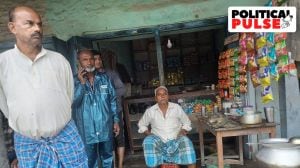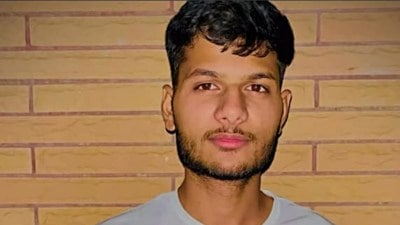At the Bhagat Singh Chowk of Baghapurana in Moga, metres away from Kotakapura that is the epicentre of the Punjab protests, around 200 young Sikhs squat blocking the road. Addressing the crowd is a young Sikh.
Clad in a long blue and orange robe — of the Khalsa Sikh panth — the “babaji” (who refuses to be identified) addresses the supporters, who are reflective of the thousands forming the backbone of Sikh protests against “desecration” of the Guru Granth Sahib.

He tells them to hold langars, “guard gurdwaras”, and ensure their voice travels, including through the social media. At one point, for several hours, the hashtag #SikhLivesMatter (taking off from #BlackLivesMatter in the US) trended for hours online.
Story continues below this ad
The “babaji” calls for peace, but with a rider. “The heart of every Sikh is boiling with anger, but we need to control it. However if there is any police action, remember you are Sikh lions and none of us is wearing bangles.”
The youths here call themselves “worshippers” of the late Punjab militant leader Jarnail Singh Bhindranwale. Almost all discontinued studies after Class XII, and work in family fields.
Balbir Singh stands brandishing a sword on the Ludhiana-Ferozepur road, near village Ajitwal in Moga. As cars approach, the teenager and his friend Ajit Singh direct them towards another road. It is the sixth day at the protest site for the two. The Class X dropouts say they don’t work, “now we are dedicated to the cause of religion”.
At Mehal Kalan in Barnala, on the Moga-Kotkapura road, a group of similarly armed youngsters in their 20s is asking shopkeepers to down shutters.
Story continues below this ad
Manpreet Singh, a farmer, joined the dharna on October 16 in Dhilwan village, Faridkot district. His anger is against “law and order failure”.
Resentment against the government unites the protesters. They are members of the Unemployed Linemen Association or the Unemployed Teachers’ Association, others have cleared the Teachers Eligibility Test and are awaiting jobs, yet more are contract employees and government school staff seeking better pay scales. Many are still waiting to be paid for MNREGA work, and then there are farmers whose crops have been damaged in the recent whitefly attack.
Peermal Singh, the president of the Unemployed Linemen Association, says their protest is that of the “common man”. “Youth fed up with the government’s approach on unemployment and inflation are streaming in.”
On the Moga-Kotakapura highway near village Rode, a group cuts down a tree and blocks the road with it, amid slogans of “Sant Bhindranwale ki jeet”. Jaggi, 22, quickly sends photos on WhatsApp to a friend. “He is home and can upload them faster,” he says.
Story continues below this ad
Rode is the native village of Bhindranwale. Youths from there declare that “the fight for dignity of Sikhs will be conclusive” this time.
The All India Sikh Student Federation is helming the protests, while other Sikh organisations such as the Sikh Students Federation (Mehta), Bhai Ghanaiya Ji Sewa Mission and Sikhi Prachaar Mission are also a part of the agitation.
Tarsem Jodhan of Swaraj Lehar, founded by rebel Aam Aadmi Party leaders, isn’t surprised at the groundswell of support. While he talks about anger over the “desecrations”, he adds, “These are all people fed up of the government. The mass protests are a wake-up call for the Badals.”
How it spread:
June 1: Guru Granth Sahib goes missing from Burj Jawahar Singh Wala village gurdwara in Faridkot district.
Story continues below this ad
June 15: Sikh activists allege followers of Dera Sacha Sauda are behind the theft.
Oct 12: Pages of allegedly the same Granth Sahib found in neighbouring Bargari.
Oct 13: Protesters clash with police, injuring nearly 10 cops.
Oct 14: Two protesters are killed in police firing in Faridkot district.
Oct 16: All FIRs against protesters withdrawn. ‘Desecrations’ have gone on.








